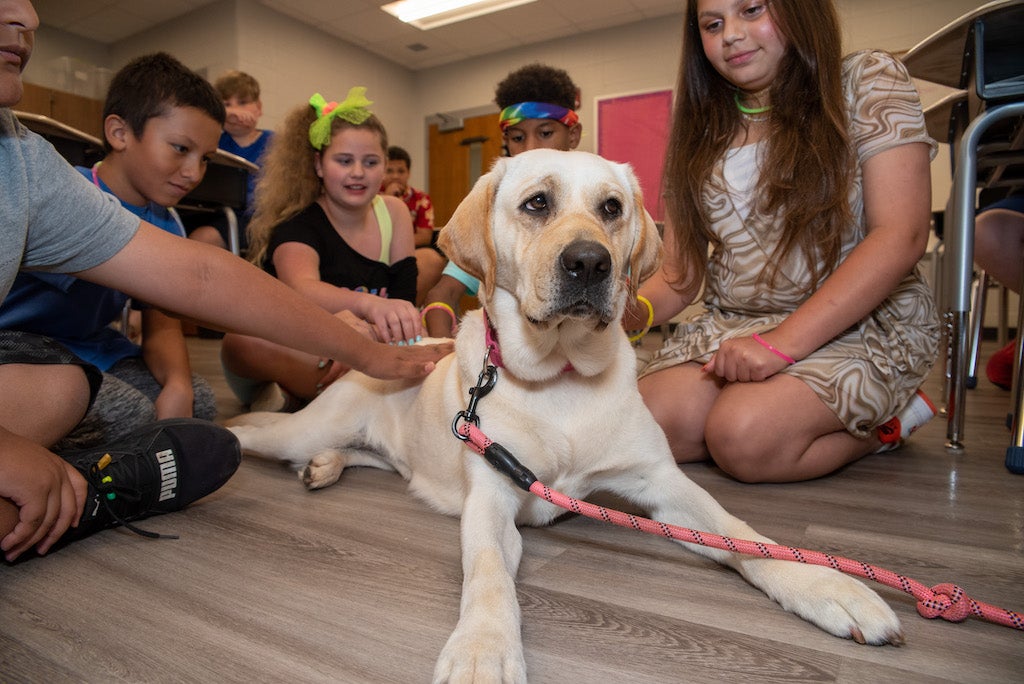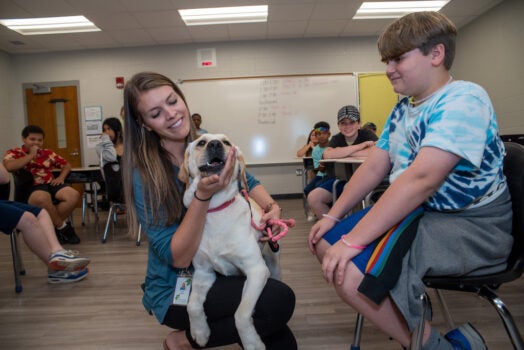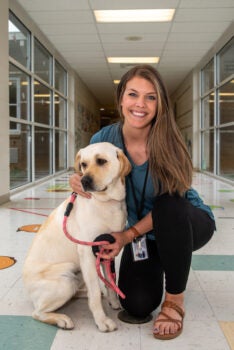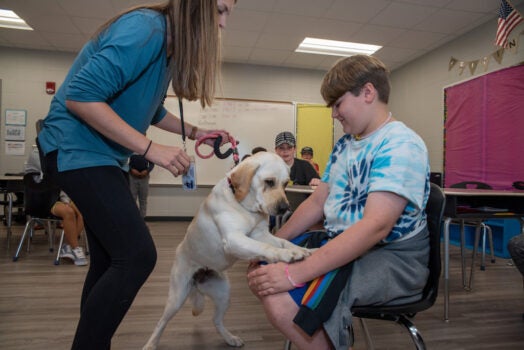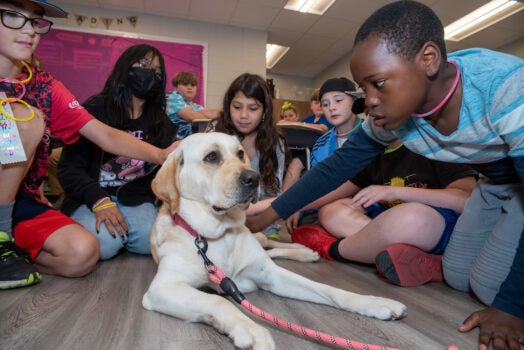PROFILE: Serving her purpose: Cricket the dog creates special learning environment for Pelham City Schools
Published 1:36 pm Friday, March 15, 2024
|
Getting your Trinity Audio player ready...
|
By BARTON PERKINS | Special to the Reporter
There’s an air of calm in Lori Goodman’s fifth-grade classroom. Kids are sitting on the floor or at their desks reading quietly to themselves, flipping through everything from the latest Dav Pilkey to The Phantom Tollbooth. Then, the classroom door swings open, a snout edges through the door and all eyes turn to Cricket’s entrance.
“She’s like our school dog,” James Nguyen, a senior at Pelham High School, said. “I feel like she just boosts the morale of the school just being around us.”
A yellow lab with an almost cream-white appearance, Cricket is the Pelham City Schools facility dog and always seems to perfectly match the energy of the environment she’s in, whether it’s the calm tranquility of a fifth-grade classroom at reading time, the nervous excitement of a group of first graders at their desk or the hectic halls of Pelham High School.
“Cricket’s just an amazing, calming tool for the children,” said Anna Nicholson, PCS’ mental health coordinator and one of Cricket’s handlers. “Any crisis that might be happening or happening, or if a kid is having a meltdown, we can walk in, and she can do something that humans just can’t do. Cricket immediately walks in and just calms them down, and it’s amazing.”
Despite her unassuming appearance, Cricket serves an essential role in Pelham’s school system. This facility dog is a vital part of the efforts being taken by Pelham City Schools to improve the mental health of its students.
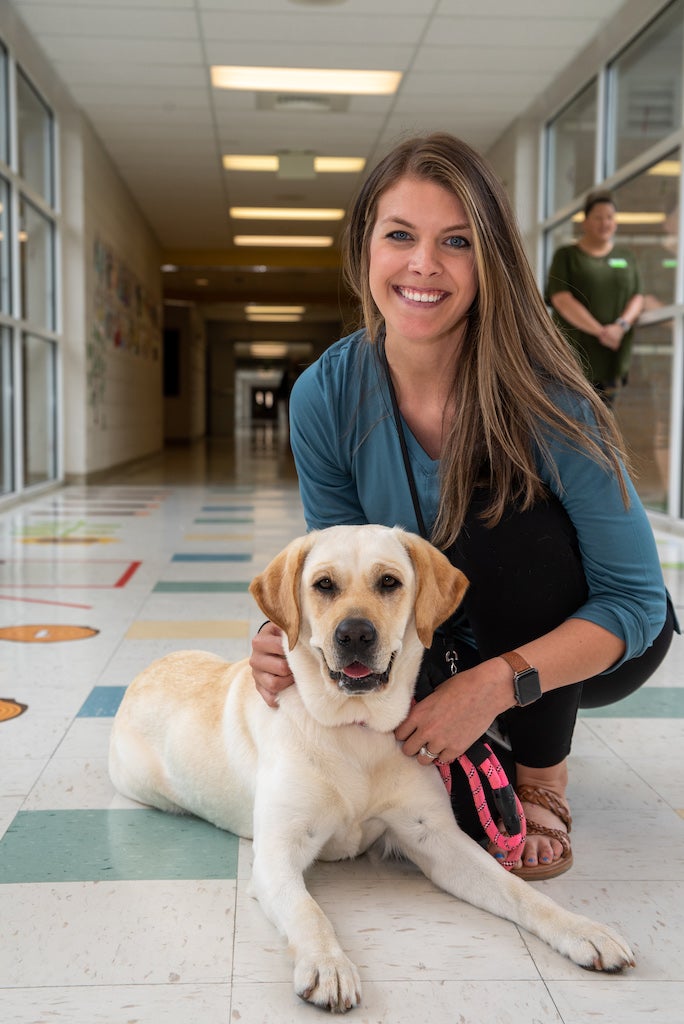
The path to Pelham
A simple nylon strip is tucked snuggly around Cricket’s mouth. It’s there not to prevent her from biting, but as a way to remind Cricket that she’s at work. That piece of plastic, and the service jacket Cricket wears, is a testament to all the training and hard work that has gone into making Cricket an amazing facility dog.
Cricket comes from the Service Dogs of Alabama, a nonprofit organization that trains labs and labradoodles for roles as facility dogs, PTSD intervention dogs and a variety of other jobs.
Four years ago, PCS applied for the necessary funding to pay for a facility dog like Cricket but the COVID-19 pandemic put the entire process on hold. It was not until the end of last school year that Cricket was finally brought into the Pelham School System, and she has proven to be a valuable asset ever since.
“The really cool thing about facility dogs is they’re trained to pick up on cortisol levels, which is the stress hormone,” Nicholson said. “So she can actually pinpoint students who just need a little bit of extra love in the classroom, and she will go lay down there by them or just go in check with those children.”
Service Dogs of Alabama begins getting its dogs ready for different jobs before they are even born. Each dog is specially bred to discourage predispositions for certain disorders, like hip dysplasia, and is trained to be confident, gentle and able to scent out stress. They are trained for roughly two years and are assigned a specific job based on each dog’s unique personality.
“Cricket is highly trained to be able to take on all these emotions,” said Pelham High School Assistant Principal Sabrina Tutchtone. “She’ll come straight to you and just make you feel so good. It’s kind of like getting a boost of caffeine in your day, only it’s better.”
Despite her pedigree and intense training, Cricket is still a dog. Both her handler and the faculty of PCS try to stay conscious of that fact whenever Cricket is brought into different classrooms. In the classes with younger students, before Cricket arrives, the students quickly start cleaning the room and putting away anything that might excite her too much or get her into trouble.
“My students know how to get ready for her, and they just love it,” said Laura Schmidt, a first-grade teacher at Pelham Oaks Elementary. “One time, though, she found a snack in one of their cubbies because we hadn’t eaten a snack yet. Cricket turned around and had this Honey Bun hanging from her mouth.”
Since then, Schmidt’s class makes sure to try and eat their snack before Cricket visits, but the ‘Honey Bun incident’ has not diminished their excitement in seeing the yellow lab at all.
“This year, I do have one little boy in particular that is in fact very concerned about dogs,” Schmidt said. “But he loves Cricket. I have a picture of him petting Cricket, and his mama thought she was gonna cry when she saw that.”
It’s not just the students who benefit from Cricket’s presence throughout PCS, the faculty and staff get just as much joy seeing the dog make its rounds through the facilities.
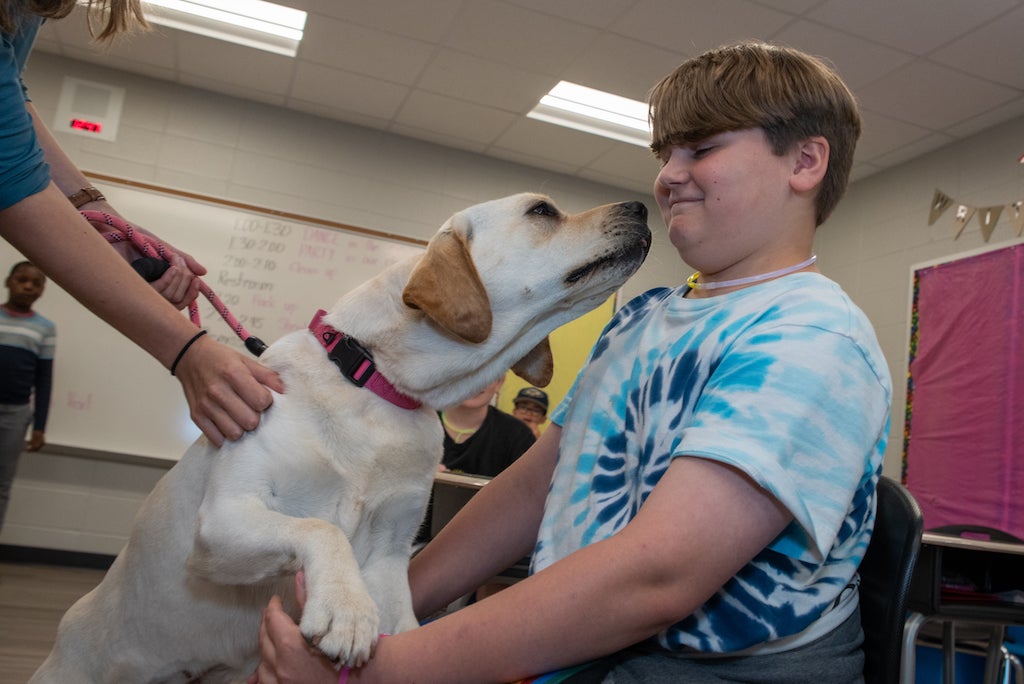
Making a difference
Whenever Cricket enters a school, she is immediately and enthusiastically greeted by the office staff manning the school’s entrance. She patiently accepts their pets, wagging her tail patiently, and she occasionally is let off her leash to visit administrators in their offices. Cricket isn’t just there for the students after all; she’s there for the entire school, faculty and staff included.
“You know, to be honest, I’m old school. I’ve been in education for 30 years,” Tutchtone said. “So when they first mentioned, ‘We’re going to get a facility dog.’ I’m like, ‘Really? Because we need more chaos in school.’”
Tutchtone was one of several faculty members who were initially skeptical about bringing a facility dog into the schools and worried that it might be an unnecessary waste of time and money for the school district.
However, that quickly changed.
“I’m the most cynical person, probably in the entire school district, because I’m probably also one of the oldest,” Tutchtone said. “It’s hard to break down my walls and my opinions, but Cricket has that ability.”
Several of the faculty, including Tutchtone, noted that since Cricket joined PCS that they feel less stressed and are often just as excited as the students to see her.
“I’m not going to say that she fixes all the problems, ” Tutchtone said. “But as far as the staff goes, I know for me personally, when Cricket walks in the door, I could be doing a million things and have a million things going through my head. But when Cricket walks in, things go away. She’ll come into my office, and she comes straight to me, probably because she detects the stress. But she’ll come straight to you and just make you feel so good.”
Cricket’s ability to detect stress and her gentle nature allow her to build positive relationships with the people around her and also make her an ideal tool in mental health interventions.
Cricket’s purpose
Since the COVID-19 pandemic, the mental health and wellness of students has been a high priority for schools throughout the United States, as youth struggle with increasingly high rates of anxiety, and Pelham is no exception, making Cricket’s presence an important part of the school.
“Anxiety, especially since COVID, has had a huge influx on our students,” Nicholson said. “I coordinate mental health services, but I’m also called into situations where a student might be struggling. And prior to Cricket, I would come in, and I’d be able to talk them down and use coping skills and all of that. But with Cricket, I can walk in, and it’s almost an immediate change. She’s just an amazing, calming tool for the children.”
Once a month, Nicholson sends a Google sign-up sheet out to the faculty of PCS to see which classes would like a visit from Cricket that week. The sheet is said to fill up rather quickly.
“I remember when Cricket was introduced and everybody was just so excited to have her on campus,” said Matthew Chaux, a senior at Pelham High School. “She’s an amazing emotional support dog. Maybe you’re just stressed or having a bad day, but the minute you see that dog, you just start feeling better.”
According to a 2019 study put out by the National Institute of Health, the presence of a dog in a classroom promotes a positive mood and has a noticeable anti-stress effect on students. This is especially pertinent as rates of stress and suicide are on the rise across the nation.
“We’ve seen a really big increase in suicidal ideations since COVID,” Nicholson said. “The anxiety of COVID, ‘if I’m going to get it, if I’m going to spread,’ it really translated from parents to children, and we’re still seeing the effects of that.”
The National Center for Health Statistics finds that the suicide rate among young people ages 10-24 increased 62 percent from 2007 through 2021, from 6.8 deaths to 11 per 100,000. According to the Centers for Disease Control and Prevention (CDC), suicide is the 10th leading cause of death in the U.S. for the entire population, and for young adults ages 10-34, it is the second leading cause of death. In 2021, Alabama reported a total of 821 total suicides.
When a student at PCS is identified as having suicidal ideation, severe depression, anxiety, or any other mental health struggles PCS has an intervention system in place that follows state-mandated protocols. Cricket occasionally joins in on interventions depending on the child and their needs.
Future
Between classroom visits and mental health interventions, Cricket has an incredibly packed schedule. Not to mention, Cricket is used by the entirety of PCS. That’s four schools, and several thousand students in total. While Cricket’s love is endless, that’s a lot for one dog, and the school system has considered investing in another.
“Initially, when we got her, we wanted to see how it worked, how she did in the schools,” Nicholson said. “We have had multiple conversations, getting more, you know, social-emotional learning grants to cover facility dogs. So we’re working on those grants to try to get more dogs like Cricket so that hopefully one day maybe each school could have one.”
Even if the district can’t find funding, Cricket will continue to work for PCS until she’s at the age to retire in six or seven years. After that, Cricket will officially become a normal house dog and move in with Nicholson. In the meantime, Cricket continues to positively impact the lives of the students she works with.
“I think one of the awesome things about Cricket is that the human ability to bond with animals is one that is not limited to any gender, wealth class or all these things that divide up high schools,” Miranda Pierce, a senior at Pelham High School said. “I feel like we’re kind of all united through our bond with Cricket.”
